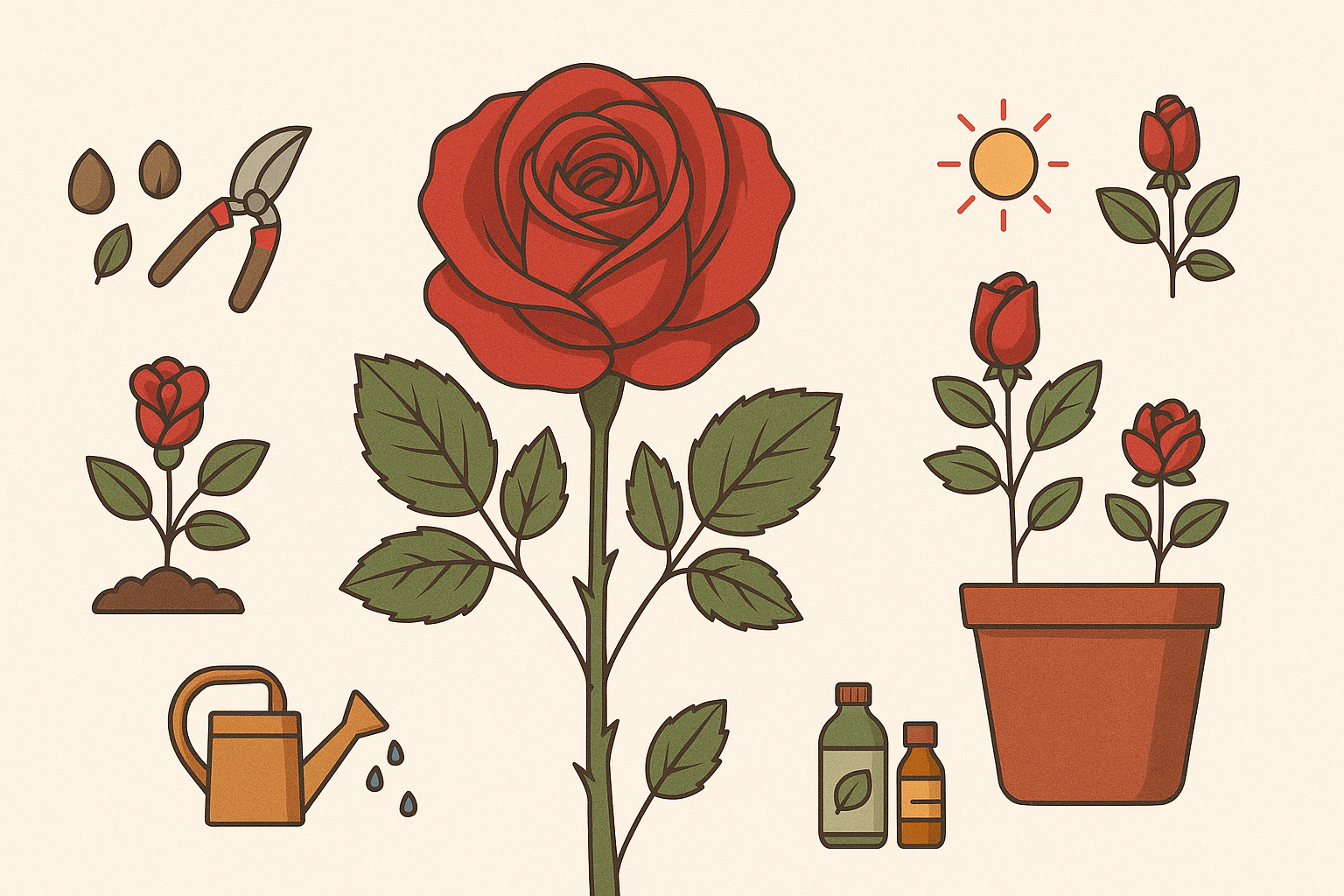Roses, the queen of flowers, have long symbolized love, beauty, and elegance. With over 2,000 species and 10,000+ cultivars, they are among the most cherished and cultivated flowering plants across the globe. Whether you’re a gardening newbie or a seasoned green thumb, this guide will walk you through everything you need to know about growing and caring for roses 🌱.
📍 Where Are Roses Grown?
Roses are perennial shrubs found worldwide, thriving in:
- 🌏 Asia
- 🌍 Europe
- 🌎 Africa
- 🌎 America
Their wide adaptability, diverse color palette, and fragrant blooms make them one of the most popular flowering plants in gardens everywhere.
🌱 How to Grow Roses: Step-by-Step
1. 🌼 Choose Your Rose Variety
With thousands of options, pick a variety suited to your climate and purpose:
- Hybrid Tea Roses: Classic, large blooms
- Floribunda Roses: Clustered flowers, great for hedges
- Climbing Roses: Perfect for fences and arches
- Miniature Roses: Great for containers and patios
2. 🏡 Decide: Pot or Garden Bed?
Roses can thrive both in pots and open garden beds:
| Container | Garden Bed |
| Easy to move | Greater root space |
| Needs regular watering | Better stability |
| Ideal for limited space | Best for large varieties |
🧪 Soil Type & Preparation
Roses love well-drained, loamy soil rich in organic matter.
Ideal Soil Conditions:
- pH Level: 6.0 – 6.5
- Add compost or well-rotted manure
- Ensure good drainage (raised beds or sandy loam)
Fertilizer Schedule 🌾
| Time | Fertilizer Type | Notes |
| Early Spring | Nitrogen-rich | Boosts leaf and stem growth |
| After Budding | Balanced NPK | Promotes blooming |
| Fall | Low-Nitrogen | Prepares for dormancy |
🌦️ Ideal Climate & Weather Conditions
Roses need moderate climates with good air circulation.
- 🌡️ Temperature: 18°C to 30°C (65°F to 85°F)
- ☀️ Sunlight: 6–8 hours of direct sunlight per day
- 💨 Avoid high humidity – increases risk of fungus
🌿 Planting Techniques
Methods of Growing Roses:
- From Seeds 🌱 – Rare; slow process
- From Cuttings ✂️ – Popular and easy
- From Buds (Budding) 🪻 – Grafting a bud onto rootstock
- Eye Grafting 👁️🌹 – Advanced method; used for hybrids
Step-by-Step Planting:
- Dig a hole twice as wide as the root ball
- Add compost and mix with soil
- Place the rose with bud union above soil level
- Backfill and firm the soil
- Water thoroughly
💧 Watering Roses
- Frequency: 2–3 times per week
- Method: Base watering preferred (avoid wetting leaves)
- Morning watering helps prevent mildew
🌞 Light & Temperature Requirements
- Minimum 6 hours of sun per day
- Avoid extreme heat or frost
- Mulch to regulate soil temperature 🌡️
🐛 Pest & Disease Control
Common Issues:
- Aphids, Spider Mites, Japanese Beetles
- Black Spot, Powdery Mildew, Rust
Treatment Schedule:
| Product Type | Example | Frequency |
| Insecticide 🐞 | Neem oil | Weekly in spring/summer |
| Fungicide 🍄 | Sulfur spray | Bi-weekly or after rain |
| Pesticide 🌾 | Imidacloprid | As per label |
| Acaricide 🕷️ | Abamectin | As needed |
💡 Always follow manufacturer instructions and wear gloves.
🌸 Rose Care & Maintenance Tips
- 🧹 Deadhead spent blooms to encourage more flowers
- ✂️ Prune annually in late winter or early spring
- 🌱 Mulch to retain moisture and suppress weeds
- 🚫 Avoid overhead watering to reduce fungal risks
✅ Dos and ❌ Don’ts
| ✅ Dos | ❌ Don’ts |
| Choose disease-resistant varieties | Overwater |
| Space plants adequately | Plant in full shade |
| Prune regularly | Ignore pest signs |
| Feed with balanced fertilizer | Use cheap potting soil |
❓ FAQs About Growing Roses
Q1: When is the best time to plant roses?
A: Early spring or fall when the weather is mild.
Q2: Can roses grow indoors?
A: Only miniature varieties, with sufficient light.
Q3: How long do roses take to bloom?
A: 6–8 weeks after planting, depending on variety.
Q4: Why are my rose leaves turning yellow?
A: Overwatering, poor drainage, or nutrient deficiency.
Q5: How do I make my roses bloom more?
A: Regular deadheading, proper fertilization, and sunlight.
📝 Final Thoughts
Growing roses is an enriching experience that rewards you with vibrant colors and heavenly fragrance. With the right techniques and care, your garden can become a blooming paradise 🌹✨.
📢 Pro Gardening Tip:
“The more you prune, the more they bloom.”
– Seasoned Rosarian Wisdom 🌺










Leave a Reply